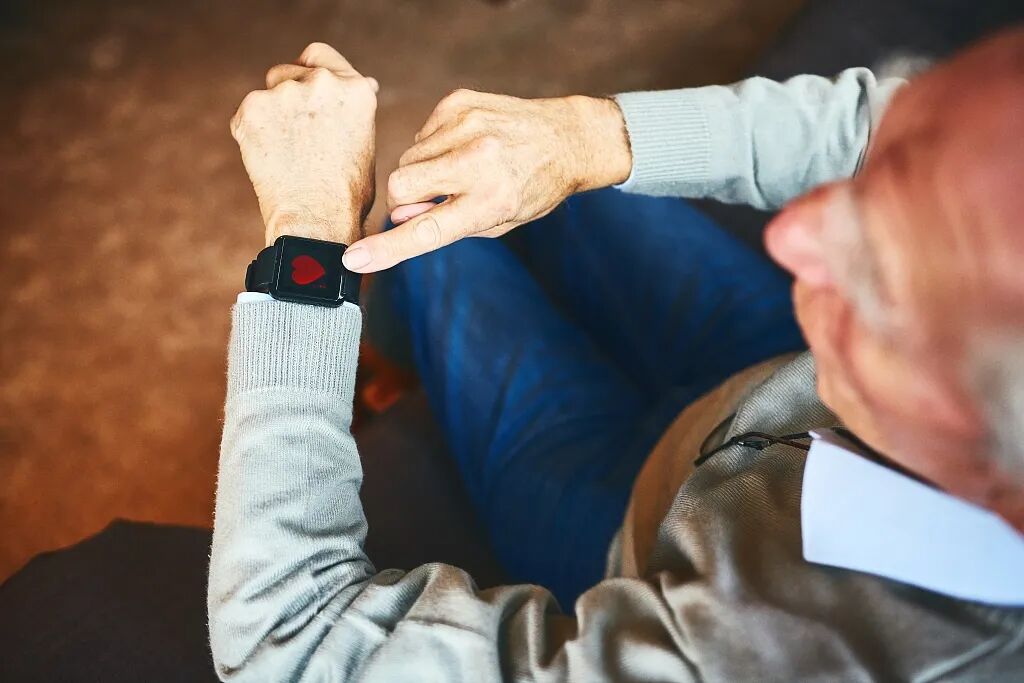
Recently, a study published in a sub-journal of Nature indicated that 63% of COVID-19 cases could be diagnosed early through data from smartwatches. It is important to note that the researchers concluded that “wearable devices such as smartwatches could potentially be applied to the early diagnosis of infectious diseases,” but many media outlets misinterpreted this to mean that smartwatches can detect COVID-19 patients, significantly exaggerating the capabilities of smartwatches and the research findings. Currently, nucleic acid testing remains the primary method for detecting the COVID-19 virus.
 Han YuePostdoctoral Fellow in Virology, University of Cambridge
Han YuePostdoctoral Fellow in Virology, University of Cambridge Recently, a study published in a sub-journal of Nature indicated that 63% of COVID-19 cases could be diagnosed early through data from smartwatches. It is important to note that the researchers concluded that “wearable devices such as smartwatches could potentially be applied to the early diagnosis of infectious diseases,” but many media outlets misinterpreted this to mean that smartwatches can detect COVID-19 patients, significantly exaggerating the capabilities of smartwatches and the research findings. Currently, nucleic acid testing remains the primary method for detecting the COVID-19 virus.Currently, most COVID-19 diagnostic methods require collecting samples from patients’ nasal fluids, saliva, or blood, and then confirming viral infection through nucleic acid testing (or along with antibody testing). If someone tells you that smartwatches can be used for virus diagnosis, you might find it quite astonishing. Recently, a new study published in a sub-journal of Nature suggested that 63% of COVID-19 cases could be diagnosed early through their established model analysis; additionally, activity tracking and health data from consumer smartwatches could be used for large-scale real-time monitoring of respiratory infections [1]. Thus, many media outlets interpreted this as “smartwatches detecting COVID-19”. What is going on here? 1. Smartwatches may have the potential to diagnose early infectious diseases, but this does not mean they can detect COVID-19It is undeniable that smartwatches collect a vast amount of data from wearers daily, such as sleep quality, exercise effectiveness, and calories burned throughout the day; in fact, wearable devices can collect up to 250,000 measurement data points from wearers daily, covering a wide range of data. In the latest study, researchers collected physiological and activity data from 32 COVID-19 infected individuals, selected from 5,300 subjects. Through data analysis, researchers found that 26 of the infected individuals exhibited changes in heart rate, daily step count, or sleep duration, accounting for 81% of the total infected individuals. Among the 25 COVID-19 infected individuals who showed physiological changes, researchers obtained specific symptom information from the patients. Further analysis revealed that 22 of the 25 infected individuals experienced physiological changes before (or at the onset of) COVID-19 symptoms, with 4 individuals showing relevant physiological changes as early as 9 days before symptom onset.By using retrospective data from smartwatches, researchers believe that 63% of COVID-19 cases could be diagnosed early through their established model analysis. In the model, researchers found that prior to symptom onset, the resting heart rate of infected individuals relative to their individual average baseline would suddenly increase, leading to the conclusion that monitoring activity data and health data from consumer wearable devices could potentially be used for large-scale, real-time detection of respiratory infections, especially before the onset of symptoms.It is important to note that the researchers ultimately concluded that wearable devices such as smartwatches could potentially be applied to the early diagnosis of infectious diseases, but this was quickly misinterpreted by some media as wearable devices successfully detecting COVID-19 patients. The two conclusions differ significantly: one indicates potential (which requires further validation), while the other suggests that the fact has already been realized.2. There are many issues to resolve before this research can be widely appliedFirst, the conclusions were drawn by analyzing changes in physiological aspects such as heart rate, daily step count, or sleep duration. However, many factors can influence these physiological processes, making it difficult to assert that COVID-19 infection is the sole cause of these changes; secondly, even if these physiological indicators change, they could be caused by other diseases, not just COVID-19; finally, the sample size used in the study was relatively small, and large-scale sample validation has not yet been achieved, nor has the accuracy of the model used in the study been truly validated. Therefore, at this stage, this method can at most serve as an auxiliary tool for disease diagnosis.Although nucleic acid testing has high sensitivity, by the time a patient is diagnosed, the virus has often already proliferated within the patient for some time. Therefore, many hope for the emergence of other “early detection” methods besides nucleic acid testing, but currently, most such methods lack comprehensive scientific mechanisms and real data validation.In the prevention and control of COVID-19, early detection of the virus, along with increased self-isolation and early treatment, is crucial for controlling the spread of the disease. We also hope for more efficient diagnostic methods to emerge soon to address these “pain points” in disease diagnosis.
Recently, a study published in a sub-journal of Nature indicated that 63% of COVID-19 cases could be diagnosed early through data from smartwatches. It is important to note that the researchers concluded that “wearable devices such as smartwatches could potentially be applied to the early diagnosis of infectious diseases,” but many media outlets misinterpreted this to mean that smartwatches can detect COVID-19 patients, significantly exaggerating the capabilities of smartwatches and the research findings. Currently, nucleic acid testing remains the primary method for detecting the COVID-19 virus.Currently, most COVID-19 diagnostic methods require collecting samples from patients’ nasal fluids, saliva, or blood, and then confirming viral infection through nucleic acid testing (or along with antibody testing). If someone tells you that smartwatches can be used for virus diagnosis, you might find it quite astonishing. Recently, a new study published in a sub-journal of Nature suggested that 63% of COVID-19 cases could be diagnosed early through their established model analysis; additionally, activity tracking and health data from consumer smartwatches could be used for large-scale real-time monitoring of respiratory infections [1]. Thus, many media outlets interpreted this as “smartwatches detecting COVID-19”. What is going on here? 1. Smartwatches may have the potential to diagnose early infectious diseases, but this does not mean they can detect COVID-19It is undeniable that smartwatches collect a vast amount of data from wearers daily, such as sleep quality, exercise effectiveness, and calories burned throughout the day; in fact, wearable devices can collect up to 250,000 measurement data points from wearers daily, covering a wide range of data. In the latest study, researchers collected physiological and activity data from 32 COVID-19 infected individuals, selected from 5,300 subjects. Through data analysis, researchers found that 26 of the infected individuals exhibited changes in heart rate, daily step count, or sleep duration, accounting for 81% of the total infected individuals. Among the 25 COVID-19 infected individuals who showed physiological changes, researchers obtained specific symptom information from the patients. Further analysis revealed that 22 of the 25 infected individuals experienced physiological changes before (or at the onset of) COVID-19 symptoms, with 4 individuals showing relevant physiological changes as early as 9 days before symptom onset.By using retrospective data from smartwatches, researchers believe that 63% of COVID-19 cases could be diagnosed early through their established model analysis. In the model, researchers found that prior to symptom onset, the resting heart rate of infected individuals relative to their individual average baseline would suddenly increase, leading to the conclusion that monitoring activity data and health data from consumer wearable devices could potentially be used for large-scale, real-time detection of respiratory infections, especially before the onset of symptoms.It is important to note that the researchers ultimately concluded that wearable devices such as smartwatches could potentially be applied to the early diagnosis of infectious diseases, but this was quickly misinterpreted by some media as wearable devices successfully detecting COVID-19 patients. The two conclusions differ significantly: one indicates potential (which requires further validation), while the other suggests that the fact has already been realized.2. There are many issues to resolve before this research can be widely appliedFirst, the conclusions were drawn by analyzing changes in physiological aspects such as heart rate, daily step count, or sleep duration. However, many factors can influence these physiological processes, making it difficult to assert that COVID-19 infection is the sole cause of these changes; secondly, even if these physiological indicators change, they could be caused by other diseases, not just COVID-19; finally, the sample size used in the study was relatively small, and large-scale sample validation has not yet been achieved, nor has the accuracy of the model used in the study been truly validated. Therefore, at this stage, this method can at most serve as an auxiliary tool for disease diagnosis.Although nucleic acid testing has high sensitivity, by the time a patient is diagnosed, the virus has often already proliferated within the patient for some time. Therefore, many hope for the emergence of other “early detection” methods besides nucleic acid testing, but currently, most such methods lack comprehensive scientific mechanisms and real data validation.In the prevention and control of COVID-19, early detection of the virus, along with increased self-isolation and early treatment, is crucial for controlling the spread of the disease. We also hope for more efficient diagnostic methods to emerge soon to address these “pain points” in disease diagnosis.
References:
[1] Tejaswini Mishra, Meng Wang, Ahmed A. Metwally, etc. Pre-symptomatic detection of COVID-19 from smartwatch data[J]. Nature Biomedical Engineering volume, 2020, 4:1208-1220.
Article edited by: fycfeng
This article is reproduced with permission from Qunmin Jiao Zhen – Tencent News (ID: qqjiaozhen), for further reproduction, please contact the original author.
Feel free to share this in your circle.
